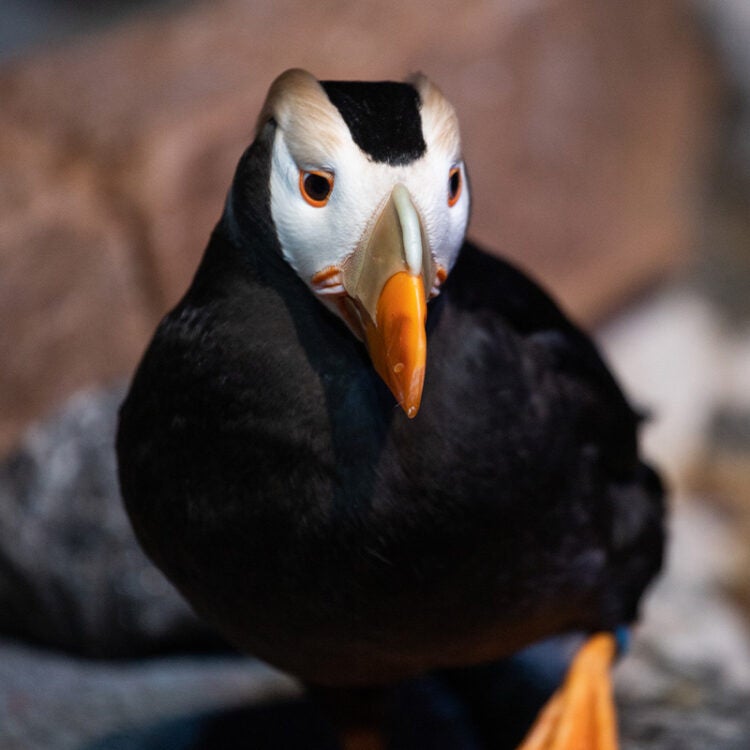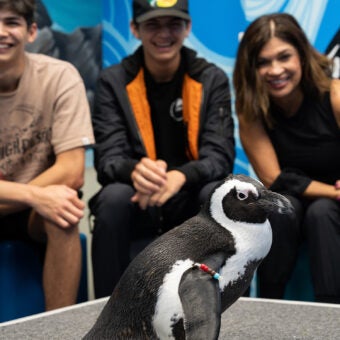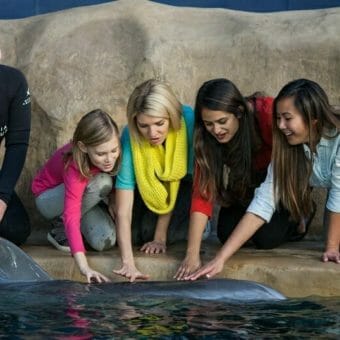-
Size
15 inches (38 cm) -
Diet
Small fish, squid, octopus, crabs, zooplankton and jellies -
Range
Northern Pacific Ocean -
Habitat
Sea coasts, rocky cliffs
Physical Characteristics
- Medium to large member of the auk, or alcid, family. The largest of the puffins, about the size of a crow.
- Size varies based on location. Western Pacific birds tend to be slightly larger than eastern birds.
- Common length of 15 inches (38 cm).
- Common wingspan of 15 inches (38 cm).
- Coloration becomes more decorative starting in the winter in preparation for the breeding season in the spring.
- The body and top of the head are brownish black, with a white face mask extending around the sides of the head to two long yellow-to-gold tufts of feathers that start above and behind the eye. Bright orange legs and feet.
- Very large, bright, mostly orange to red bill during mating season, which may have yellow or greenish markings.
- After the breeding season, they lose their tufts, and the bill fades to a duller orange or reddish-brown. The belly may be spotted with paler brown speckles.
- Males and females are similar in appearance. Males are larger.
- Juveniles are similar to adults, except with a grey-brown breast, white belly and brown bill.
Animal Fun Fact
The tufted puffin's genus name, Fratercula, means “little brother” in Latin, a reference the black and white coloration of these birds, which resembles the robes of a monk.
Diet / Feeding
- Diet consists primarily of anchovies and other small fish, as well as squid, octopus, crabs, zooplankton and jellies.
- Chicks’ diets are almost entirely fish, while adult diet is more varied.
- Feeds by diving underwater in pursuit of prey.
- Forages over waters close to breeding colonies, unless iced over.
- May capture and hold multiple small fish crosswise in the bill to bring to chicks – often carrying 5 to 20 fish at a time, but may carry up to 60 fish at once. Adults eat their own food while foraging underwater.
Range / Habitat
- Northern Pacific along the coast of Japan to Northeast Asia and from Southern California to Alaska.
- A pelagic seabird. Spends much of the year offshore; returns to the coast to nest and raise chicks.
- During the breeding season, found along sea coasts, rocky cliffs and offshore islands.
- During the non-breeding season, ranges over adjacent waters usually only to the edge of the continental shelf.
Reproduction & Growth
- Forms large breeding colonies on the shores of islands and coastal areas throughout its range, often mixed with other puffins and auks.
- Prefers to nest in areas with steep, grassy slopes suitable for burrowing, though may build nests on rocky cliffs too. Higher areas are preferred because this allows birds to dive down and gain momentum in order to take flight.
- Breeds once yearly, usually starting in April, though mating may begin as early as March or as late as May. Peak egg-laying period is usually about two weeks for each colony. Eggs laid later than June are unlikely to produce fledglings.
- Forms monogamous pairs.
- Mating may take place either in the water or on land.
- Courtship rituals include flying straight up, or skypointing, strutting and billing.
- Each mating pair produces one off-white egg per season, sometimes with light blue or brown markings.
- Both parents protect and incubate the egg until it hatches after about 40-53 days.
- Parents continue to care for and feed the chick until fledging at about 45-55 days.
- Both males and females reach reproductive maturity between 3-4 years of age.
Conservation Status
- “Least Concern” on the IUCN Red List.
- Abundant in Alaska, where federal and state laws protect seabird colonies.
- Colonies along the coasts of California, Oregon and Washington have been declining since the beginning of the century due to decreasing numbers of fish, ocean pollution and oil spills.







